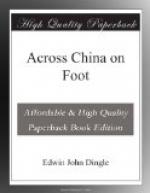Probably the Nou Su tribes are what Major Davies calls the Lolo Group in his third division of the great Tibeto-Burman Family; but I merely suggest it, as it strikes me that the other branches of that group, including the Li-su, the La-hu, and the Wo-ni, seem to be descendants of a larger group, of which the Nou Su predominate in numbers, language, and customs. However, this by the way.
It may not be common knowledge that in most parts of the Chinese Empire, even to-day, there are tribes of people, essentially non-Chinese, who still rigidly maintain their independence, governed by their own native rulers as they were probably forty centuries ago, long before their kingdoms were annexed to China Proper. There are white bones and black bones, noses long and flattened, eyes straight and oblique, swarthy faces, faces yellow and white, coal-black and brown hair, and many other physical peculiarities differentiating one tribe from another.
In many instances, these tribes, conquered slowly by the encroaching Chinese during the long and tedious term of centuries marking the growth of the Chinese Empire to its present immensity, are allowed to maintain their social independence under their own chiefs, who are subject to the control of the Government of China—which means that excessive taxation is paid to the yamen functionary, who extorts money from anybody and everybody he can get into his clutches, and then gives a free hand. Others, in a further state of civilization, have been gradually absorbed by the Chinese and are now barely distinguishable from the Han Ren (the Chinese). And others, again, adopting Chinese dress, customs and language, would give the traveler a rough time of it were he to suggest that they are any but pure Chinese. To the ethnological student, it is obvious that so soon as the Chinese have tyrannized sufficiently and in their own inimitable way preyed upon these feudal landlords enough to warrant their lands being confiscated, reducing a tribe to a condition in which, far removed from districts where co-tribesmen live, they have no status, the aboriginals throw in their lot gradually with the Chinese, and to all intents and purposes become Chinese in language, customs, trade and life. This absorption by the Chinese of many tribes, stretching from the Burmese border to the eastern parts of Szech’wan, whilst an interesting study, shows that the onward march of civilization in China will sweep all racial relicts from the face of this great awakening Empire.
But at the same time there are many branches of a tribal family, some found as far west as British Burma and all more or less scattered and disorganized as the result of this silent oppression going on through the years, who still are ambitious of preserving their independent isolation, particularly in sparsely-populated spheres far removed from political activity. So remote are the districts in which these principalities are found, that the Chinese themselves are entirely ignorant of the characteristics of these tribes. They say of one tribe which is scattered all over China Far West that they all have tails; and of another tribe that the men and women have two faces! And into the official records published by the Imperial Government the grossest inaccuracies creep concerning the origin of these peoples.




